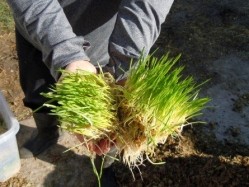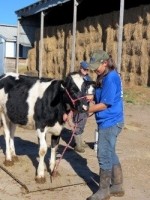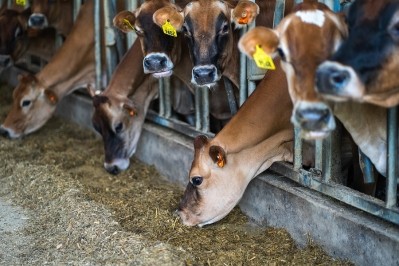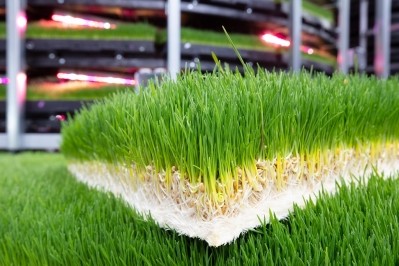Will dairy cows eat their hydroponic sprouts?

Sprouted barley grown indoors without soil could provide an alternative feed for livestock but few scientific studies have been done on such feedstuffs, said South Dakota State University (SDSU) assistant dairy science professor, Jill Anderson.
The cultivation of plants using mineral nutrient solutions, in water, without soil is known as hydroponics. Hydroponic feed is essentially the germination of a seed, sprouted into an animal food.
Most of the information on hydroponic feeds, in general, is anecdotal, she explained.
“Barley sprouts have good yields and a high feed value, which is why they were chosen for this research. There has been some preliminary research out of the University of Minnesota on growing oats, wheat, rye, or triticale sprouts as well. The possibilities of what feeds can be grown hydroponically is still being explored,” Anderson told FeedNavigator.
Along with doctoral student Rhea Lawrence, she is carrying out controlled studies on two treatment groups on behalf of HydroGreen Global Technologies, which supplied sprouted barley daily during feeding trials carried out by the SDSU team. The firm sought independent verification of the hydroponic feed.
In terms of what kind of challenges exist around using such raw materials in dairy diets, Anderson said:
“The water content of the hydroponic feed can be very high, which may limit how much can be included in the diet due to gut fill. Future research is need to figure out optimal feeding rates under different feeding scenarios.
“Most dairy producers are used to using feeds like corn silage that also can have a lot of moisture so they should have the equipment to handle feeding the hydroponically grown feeds. There are also several considerations for setting up the equipment to grow the feed on a farm.”
Trials
Anderson and Lawrence conducted a six week sprouted barley feeding trial for 20 lactating dairy cows, which was completed in early July, focusing on milk production, while a 12 week feeding trial for 24 dairy heifers examined growth performance.
“We are still working on the results and laboratory analysis so it is hard to state all the potential benefits at this time. It is a very palatable feed with high digestibility. We hypothesize it will have benefits for rumen health and function,” said Anderson.
She noted both heifers and lactating cows tend to sort for it, even though the researchers tried “to mix it in.”
For half of the animals in each study, the researchers replaced a portion of the ground corn and soybean meal in a typical diet with hydroponic feed.
The researchers performed a lab analysis on the feed, taking out the moisture and then calculating the other nutrients. Then they took it back to the farm and recalculated it on an as fed basis, said Anderson. That substitution, she continued, amounted to 8% of the ration figured on a dry-matter basis for the lactating cows and 14% for the heifers.
Lactating cows typically eat about 100 to 150 pounds of a total mixed ration, she explained. The cows in the treatment group consumed 20 to 30 pounds of hydroponic feed. Feed intake for both groups was similar on a dry-matter basis, she said.
Milk production
Preliminary results show that lactating cows on hydroponic feed produced similar amounts of milk, said Anderson. However, she stressed there were weeks during the hottest parts of the summer in July when the results were different.
Cows on hydroponic feed also produced milk with the same fat and protein content levels as the control group. The researchers are also set to analyze fatty acid composition in the milk fat.
In addition, the researchers took blood and fecal samples for analysis. The fecal samples are to measure total tract digestion of nutrients and the blood samples allow the researchers to look at metabolic profiles, which indicate how the cows were partitioning energy during the trial, Anderson explained.
Each dairy heifer began the feeding trial when she was 6 months old and completed it at 9 months old, she said.
The heifers consumed 30 to 40 pounds per day of a total mixed ration and the treatment group was eating 10 to 15 pounds of hydroponic feed per day, reported the team.
To evaluate growth performance, they documented body weight and took body frame measurements, including height of hips and withers, every two weeks. The feeding trials for the last group of heifers only concluded in November.
Anderson said the dairy heifer research can lay some groundwork for future studies using hydroponic feed for other growing animals, such as beef cattle and sheep.









